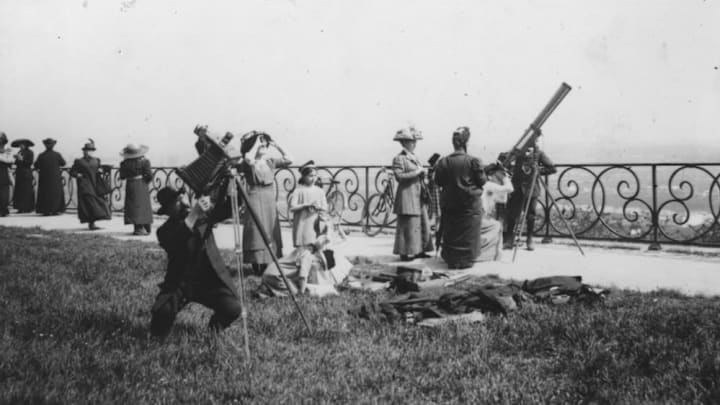Ahead of the total solar eclipse on August 21, 2017, take a peek at these old photos of Earthlings with their eyes glued to the skies.
1. TAKING IN A TOTAL SOLAR ECLIPSE OVER FRANCE // APRIL 1912

The position of the Parisian suburb of St. Germain-en-Laye, which overlooked the Seine, “offered an admirable vantage ground,” for the April 17, 1912 total solar eclipse, according to the magazine Popular Astronomy. “The unusual spectacle of the approaching event had induced a large number of Parisians to make the 12-mile journey which separates this spot from the capital, and before 10:15 a.m., an animated crowd, numbering some thousands, had assembled.”
2. WORKERS WATCH AN ECLIPSE FROM THEIR OFFICE ROOF // APRIL 8, 1921

Will you be watching the August 21 eclipse with your coworkers, as this group did in 1921? Here are a few tips from the experts for how to get the most out of your viewing experience.
3. A WOMAN VIEWS AN ECLIPSE USING GOGGLES SET INTO A MASK // APRIL 1921

Watching an eclipse without the aid of special glasses will damage your vision. This woman watched the April 1921 eclipse with a mask you might be seeing in your nightmares.
4. WATCHING THE ECLIPSE FROM A COLLEGE IN LANCASHIRE, ENGLAND // JUNE 1927

A crowd at Stonyhurst College gathers to watch a total solar eclipse. “The narrow belt of totality, only about 28 miles wide, swept across England in a line to include parts of North Wales, Lancashire, and Yorkshire,” one writer noted. “Thousands upon thousands of spectators were gathered at various centers in the totality, from one side of England to the other, only to be greeted on the great day with a drenching and hopeless dawn of impenetrable clouds.”
5. NURSES WATCH AN ECLIPSE // JUNE 1927

These nurses took a break from work to look skyward at the total eclipse.
6. VIEWING A TOTAL SOLAR ECLIPSE OVER LONDON THROUGH SMOKED GLASS // JUNE 29, 1927

A group of ladies leans out a window to watch the eclipse through smoked glass.
7. SOCCER SPECTATORS TAKE IN AN ECLIPSE // APRIL 4, 1936

The fans taking in a match between West Ham United and Aston Villa at Upton Park in London also had the opportunity to see an eclipse.
8. WATCHING THE ECLIPSE IN LONDON // JUNE 19, 1936

This group stopped in the streets of Hornsey, London to take in the eclipse.
9. TOTAL ECLIPSE IN KHARTOUM // 1952

Astronomer George Van Biesbroeck from the Yerkes Observatory in Chicago and a man named John Ladd observed the total eclipse of the sun at the National Geographical Society's Camp in Khartoum.
10. FLEET STREET ECLIPSE WATCHERS // JUNE 30, 1954

Though some lucky eclipse chasers got a total solar eclipse in June 1954, England, where these women were watching, got just a partial eclipse. The last total eclipse over England had taken place in 1927; there wouldn’t be another until 1999.
11. NORTH LONDON STUDENTS WATCH WITH THEIR HEADMASTER // JUNE 30, 1954

"As the eclipse started, I remember seeing the dark shadow on the Sun starting to become larger," one eyewitness to the eclipse, who was 13 at the time, recalled. "The clouds prevented us [from] seeing the eclipse, but I do recall the atmosphere becoming very dark and still, and noticed that the birds had stopped singing." You can read other accounts of the eclipse here.
12. WATCHING THE ECLIPSE IN A BUCKET // 1954

These students looked at a reflection of the eclipse in a bucket of water, but even that can damage your eyes. NASA has guidelines for safely viewing the eclipse here.
13. LONDON // JUNE 30, 1954

People gathered on the streets of London outside St. Paul's Cathedral to watch the eclipse.
